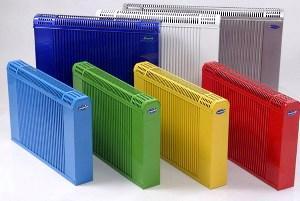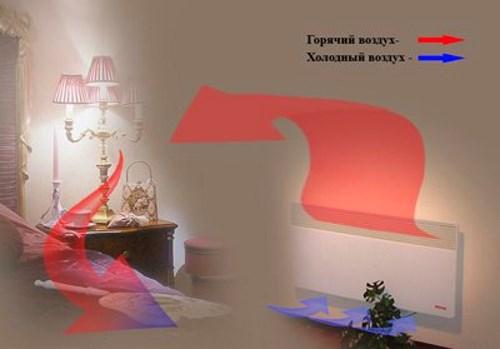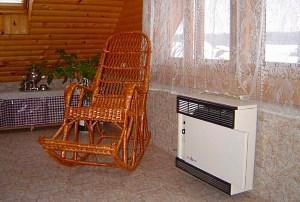The principle of operation of a convector heater
 The market for HVAC equipment for home and office is diverse. A significant proportion of devices are heaters of various types. Let's consider how a convector heater differs, the principle of operation of this device.
The market for HVAC equipment for home and office is diverse. A significant proportion of devices are heaters of various types. Let's consider how a convector heater differs, the principle of operation of this device.
Three types of heat transfer
Heat transfer from a warm object to a cold one occurs in three ways:
- Direct heat transfer is the direct transfer of heat when objects come into contact with different temperatures. Heat transfer occurs due to the Brownian motion of molecules and the transfer of energy when molecules collide. The principle of heat transfer is used in electric stoves.
- The higher the temperature of the heated object, the more active is the transfer of energy by radiation. This phenomenon is used in infrared heaters. The difference between this type of heating: it is not the air that heats up, but the objects on which the rays fall.
- The third type of heat exchange is convection, that is, heat transfer through the movement of heated air.
Let's consider how a convector heater works.
Its functioning is based on air convection. The heated air expands, becomes lighter and rises, while the cold air sinks down. The heating element is located inside a housing with openings in the lower and upper parts. Cold air enters the device through the bottom vents; during the heating process, air expands and exits through the upper openings. The air circulates silently in the room and the temperature gradually rises.

Eco-friendly principle of operation of a convector heater
Among the advantages of this equipment are safety and environmental friendliness. Electric heaters of convector type work as follows.
 The heating element, located inside the housing, has a safe temperature, its efficiency is determined by the large heating area and the correct direction of the air flow. Touching the heater cannot cause burns. The increased temperature of the heater is not high enough to cause chemical reactions in the air. This means that oxygen in the room does not burn out, carbon dioxide and nitric oxide are not formed.
The heating element, located inside the housing, has a safe temperature, its efficiency is determined by the large heating area and the correct direction of the air flow. Touching the heater cannot cause burns. The increased temperature of the heater is not high enough to cause chemical reactions in the air. This means that oxygen in the room does not burn out, carbon dioxide and nitric oxide are not formed.
If we compare a fan heater and a convector heater, then it should be noted that a fan heater heats the room faster, but at the same time it uses elements that are heated to high temperatures and worsen the air condition.
The convector heater is not so fast, but environmentally friendly.
The principle of operation of a convector heater - maintaining a stable temperature
 If the cold air entering the heater has a sufficiently high temperature, then the electric current is temporarily turned off. This process is monitored by electronics. A temperature sensor is located on the body, information is transmitted to an automatic device that turns on or off the supply of electric current. This system eliminates overheating of the air in the room. Some types of heaters have a digital indicator that displays the temperature in the room.
If the cold air entering the heater has a sufficiently high temperature, then the electric current is temporarily turned off. This process is monitored by electronics. A temperature sensor is located on the body, information is transmitted to an automatic device that turns on or off the supply of electric current. This system eliminates overheating of the air in the room. Some types of heaters have a digital indicator that displays the temperature in the room.
How does a convector heater work in autumn and winter?
The maximum power of the convector heater is 2 kW. This is enough to maintain a comfortable indoor temperature of no more than 20 square meters, provided that the temperature outside the window does not drop below zero.Such a heater is effective during the fall in temperature.
 In winter, during frosts, the power of 2 kW is insufficient to heat the room. A convector heater will not replace central heating, but it can serve as an additional source of heat during frosty weather.
In winter, during frosts, the power of 2 kW is insufficient to heat the room. A convector heater will not replace central heating, but it can serve as an additional source of heat during frosty weather.
In addition to power, for this type of heaters, the volume of circulated air plays an important role. It is necessary to remember how a convector heater works: air in the room must pass through it during circulation. It is generally accepted that 1 kW of heater power is required for every ten square meters. If the room has an area of more than 20 square meters, then one heater is indispensable - there should be at least two of them.
Is it possible to improve heating efficiency by installing tightly closing windows and doors? In general, heating the air will become more efficient, but the hygienic norms for the composition of the air may be violated. The problem is that a certain volume of air cannot be constantly present in a residential area; ventilation is required. With an area of 20 square meters, an hourly exchange of 20 cubic meters of air is required. If the air entering the room passes through the convector, people will not feel the sudden cooling in the room.
Construction and design of convector heaters
Convector heaters are flat panels. They have a significant lateral surface and a small thickness. Structurally, these devices are divided into wall and floor.
The wall-mounted version saves space. The pleasant light color of the body contributes to the fact that the heater fits naturally into the interior.
The floor construction has its advantages: the heating panel is installed on casters, the heater can be moved around the room.